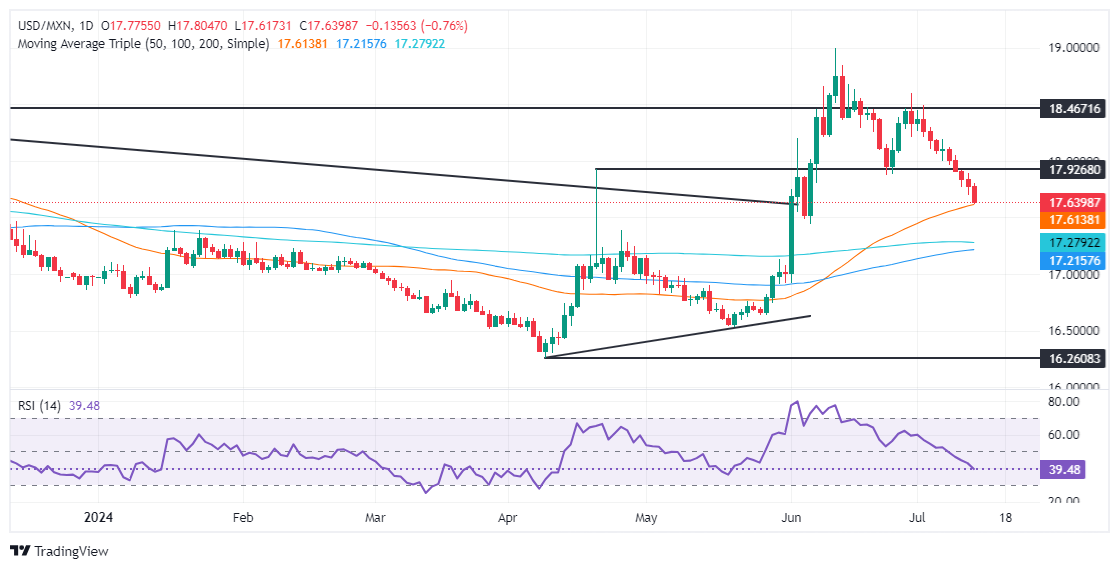- The Mexican Peso extends gains as USD/MXN hits 17.68 after touching a five-week low of 17.62.
- Mexico’s industrial output rebounds in May, signaling resilience amid economic slowdown.
- Banxico minutes suggest possible rate adjustments as US producer inflation rises and consumer sentiment deteriorates.
The Mexican Peso extended its rally for a ninth consecutive day of trading against the Dollar on Friday following the release of Mexico’s industrial production figures and US June inflation data on the producer side. USD/MXN is trading at 17.68, renewing five-week lows of 17.62.
Despite the annual weakening, Mexico’s industrial production showed resilience by rebounding in May, following a monthly decline in April. This recovery underlines a positive outlook amid the country’s economic slowdown.
Meanwhile, the latest minutes of the Bank of Mexico (Banxico) revealed that the disinflation process has evolved and could lead to discussions to adjust interest rates at upcoming meetings. The board acknowledged the strength of the labor market, although it noted that growth has shown signs of weakness.
Meanwhile, José Luis Ortega, CIO of Black Rock Mexico, commented that inflation in Mexico will not return to Banxico’s 3% target by the end of 2025. He added that Banxico’s easing cycle will be gradual, although adjustments will continue.
Across the border, the latest inflation data released by the US Bureau of Labor Statistics (BLS) showed prices paid by producers rose above economists’ estimates, while US consumer sentiment released by the University of Michigan (UoM) deteriorated.
Meanwhile, Federal Reserve (Fed) officials grabbed the headlines and remained cautious about monetary policy changes. Chicago Fed President Goolsbee said recent inflation data is “favorable” and could shorten the Fed’s last mile on inflation.
St. Louis Fed President Alberto Musalem said the current interest rate level is appropriate for current conditions and he sees the economy growing between 1.5% and 2% this year.
Daily Market Summary: Mexican Peso Extends Gains Despite Banxico’s Dovish Tone
- Banxico board members project that growth will be lower than expected as Mexico’s economic activity has been weak since late 2023. Most policymakers mentioned that inflation will converge toward the target in the last quarter of 2025.
- They added that services inflation is not showing a clear downward trend, which was one of the reasons for keeping rates unchanged at the June meeting.
- Mexico’s industrial production (IP) in May was 0.7% m/m, up from -0.4% in April and estimates of 0.4%. In the 12 months through May, IP was 1%, which fell sharply from 5.1% in April and missed the projected 1.2%.
- Mexico’s June inflation figures came in higher than expected due to a rise in food prices, when most economists expect Banxico to resume cutting interest rates.
- The US Producer Price Index (PPI) for June expanded by 0.2% on a monthly basis, higher than the 0.1% expected and above the 0% seen in May. The core PPI was higher than expected, at 0.4% on a monthly basis.
- On an annual basis, the PPI rose from 2.4% to 2.6%, above expectations of 2.3%. Core inflation was 3%, compared to 2.6%.
- UoM consumer sentiment fell from 68.2 in June to 66.0 in July. One-year inflation expectations were as expected at 2.9%, down from 3%.
- The US Dollar Index (DXY), which tracks the value of a basket of six currencies against the US dollar, fell more than 0.30% to 104.12.
- According to CME FedWatch data, the probability of a September rate cut is 88%, up from 85% on Thursday.
Technical Analysis: Mexican Peso Capitalizes on USD Weakness as USD/MXN Dips Below 17.70
The USD/MXN continues to fall, with traders targeting a test of the psychological level of 17.50. Momentum remains on the side of the sellers, as shown by the Relative Strength Index (RSI), although key support levels on the exotic pair will soon be tested.
If USD/MXN falls below 17.60, the next support would be the confluence of the December 5 high and the 50-day simple moving average (SMA) near 17.56/60, followed by the 200-day SMA at 17.28. Further losses would test the 100-day SMA at 17.20.
Conversely, USD/MXN buyers need to clear the June 24 cycle low of 17.87, which has turned into resistance, before challenging the 18.00 figure. Further upside potential is seen above the July 5 high at 18.19, followed by the June 28 high of 18.59, allowing buyers to target the yearly high of 18.99.
Mexican Peso FAQs
The Mexican Peso is the legal currency of Mexico. The MXN is the most traded currency in Latin America and the third most traded currency in the Americas. The Mexican Peso is the first currency in the world to use the $ sign, prior to the later use of the Dollar. The Mexican Peso or MXN is divided into 100 cents.
Banxico is the Bank of Mexico, the country’s central bank. Created in 1925, it provides the national currency, the MXN, and its primary objective is to preserve its value over time. In addition, the Bank of Mexico manages the country’s international reserves, acts as a lender of last resort to the banking sector, and provides economic and financial advice to the government. Banxico uses the tools and techniques of monetary policy to achieve its objective.
When inflation is high, the value of the Mexican Peso (MXN) tends to decrease. This implies an increase in the cost of living for Mexicans, which affects their ability to invest and save. In general, inflation affects the Mexican economy because Mexico imports a significant amount of final consumer products, such as gas, fuel, food, clothing, etc., and a large amount of production inputs. On the other hand, the higher the inflation and debt, the less attractive the country is for investors.
The exchange rate between the USD and the MXN affects imports and exports between the United States and Mexico, potentially affecting demand and trade flows. The price of the Dollar against the Mexican Peso is affected by factors such as monetary policy, interest rates, the consumer price index, economic growth and some geopolitical decisions.
The exchange rate between the USD and the MXN affects imports and exports between the United States and Mexico, potentially affecting demand and trade flows. The price of the Dollar against the Mexican Peso is affected by factors such as monetary policy, interest rates, the consumer price index, economic growth and some geopolitical decisions.
Source: Fx Street
I am Joshua Winder, a senior-level journalist and editor at World Stock Market. I specialize in covering news related to the stock market and economic trends. With more than 8 years of experience in this field, I have become an expert in financial reporting.








